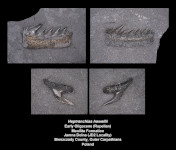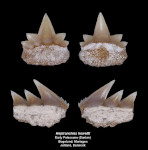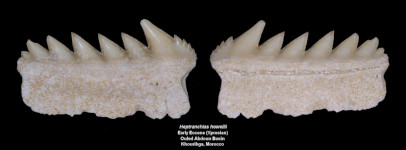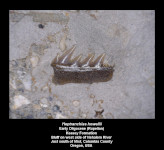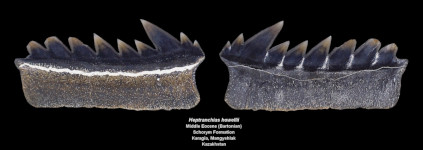Heptranchias howellii
(Reed, 1946)
Classification: Elasmobranchii Hexanchiformes Hexanchidae
Reference of the original description
A new species of fossil shark from New Jersey. Notulae Naturae, 172, 1–3
A new species of fossil shark from New Jersey. Notulae Naturae, 172, 1–3
Image of the original description
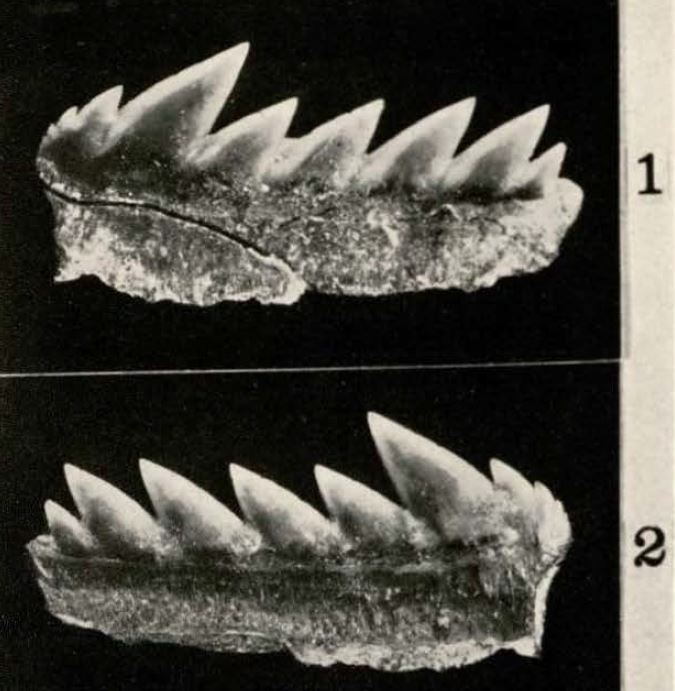
Heptranchias howellii (Reed, 1946); holotype, original image of the first description, Shark River formation, Eocene, New Jersey, 13 mm length, ANSP no. 15078

Heptranchias howellii (Reed, 1946); holotype, original image of the first description, Shark River formation, Eocene, New Jersey, 13 mm length, ANSP no. 15078
Synonyms / new combinations and misspellings
Heptranchias cf. howelli, Heptranchias cf. howellii, Heptranchias howelli, Notidanion howellii
Heptranchias cf. howelli, Heptranchias cf. howellii, Heptranchias howelli, Notidanion howellii
Types
Heptranchias howellii
Heptranchias howellii
Description:
Citation: Heptranchias howellii (Reed, 1946): In: Database of fossil elasmobranch teeth www.shark-references.com, World Wide Web electronic publication, Version 04/2024
Please send your images of "Heptranchias howellii" to info@shark-references.com

Heptranchias howellii (Reed, 1946), Jamna Dolna (JD2 Locality), Bieszczady Country, Outer Carpathians, Poland, Menilite Formatioon, Early Oligocene, Rupelian, collection and © Adam Anderson

Heptranchias howellii (Reed, 1946), Jamna Dolna (JD2 Locality), Bieszczady Country, Outer Carpathians, Poland, Menilite Formatioon, Early Oligocene, Rupelian, collection and © Adam Anderson
Distribution Geographic
type locality: Beach at Belmar, Monmouth County, New Jersey;
other localities: Jamna Dolna (JD2 Locality), Bieszczady Country, Outer Carpathians, Poland [25358], collection Adam Anderson, Tasmania; Bogelund, Mariagen, Jutland, Denmark, collection Adam Anderson, Tasmania; Frederica, Trelde Naes, Jutland, Denmark, collectionAdam Anderson; Ouled Abdoun Basin, Khouribga, Morocco, collection Adam Anderson, Tasmania; Martinovics Quarry, Kissvabhegy, Budapest, Hungary, collection Adam Anderson, Tasmania;
Distribution of Heptranchidae show google map
type locality: Beach at Belmar, Monmouth County, New Jersey;
other localities: Jamna Dolna (JD2 Locality), Bieszczady Country, Outer Carpathians, Poland [25358], collection Adam Anderson, Tasmania; Bogelund, Mariagen, Jutland, Denmark, collection Adam Anderson, Tasmania; Frederica, Trelde Naes, Jutland, Denmark, collectionAdam Anderson; Ouled Abdoun Basin, Khouribga, Morocco, collection Adam Anderson, Tasmania; Martinovics Quarry, Kissvabhegy, Budapest, Hungary, collection Adam Anderson, Tasmania;
Distribution of Heptranchidae show google map
Distribution Strategraphy
Shark River formation, Eocene [2003]; Menilite Formatioon, Early Oligocene, Rupelian [25358]; Early Paleocene (Danian), collection Adam Anderson; Early to Middle Eocene (Late Ypresian to Middle Lutetian), Lillebaelt Clay Formation, collection Adam Anderson; Early Eocene (Ypresian) collection Adam Anderson, Tasmania; Late Eocene (Priabonian), Szepvolgy Limestone Formation, collection Adam Anderson, Tasmania;
Shark River formation, Eocene [2003]; Menilite Formatioon, Early Oligocene, Rupelian [25358]; Early Paleocene (Danian), collection Adam Anderson; Early to Middle Eocene (Late Ypresian to Middle Lutetian), Lillebaelt Clay Formation, collection Adam Anderson; Early Eocene (Ypresian) collection Adam Anderson, Tasmania; Late Eocene (Priabonian), Szepvolgy Limestone Formation, collection Adam Anderson, Tasmania;
Material
1 tooth collection nr. ANSP no. 15078 [2003]; 3 teeth (V.61.814., VER 2016.3452., VER 2016.3453.) [25358]
1 tooth collection nr. ANSP no. 15078 [2003]; 3 teeth (V.61.814., VER 2016.3452., VER 2016.3453.) [25358]
Description
Original description after Reed [2003]: The species is founded on a single lateral tooth from the upper jaw. The length is about 13 mm., the height from the lower margin of the root to the tip of the principal cone is about 7 mm, and the height of the principal cone above the root is about 4 mm. The principal cone is preceded by a group of 3 or 4 denticles, the first of which is comparatively large, but all decrease rapidly in size as they approach the root, giving somewhat the effect of a miniature cockscomb. The principal cone is followed by four accessory cones which are all the same size, and a fifth accessory cone which is very small. There is an indication of a denticle at the extreme posterior end. The cutting edges of the tooth :are entire, and are so thin as to be almost translucent. The tooth is similarly convex on both the inner and outer sides, and is well compressed. The root is straight on the outer side, convex on the inner, with the base tapering to a thickness about equal to that at the base of the crown, so that in profile the root is roughly the shape of a half circle. The tooth as a whole is very slightly twisted, but the cones and denticles are set straight on the root, and are not at all sigmoid.
Original description after Reed [2003]: The species is founded on a single lateral tooth from the upper jaw. The length is about 13 mm., the height from the lower margin of the root to the tip of the principal cone is about 7 mm, and the height of the principal cone above the root is about 4 mm. The principal cone is preceded by a group of 3 or 4 denticles, the first of which is comparatively large, but all decrease rapidly in size as they approach the root, giving somewhat the effect of a miniature cockscomb. The principal cone is followed by four accessory cones which are all the same size, and a fifth accessory cone which is very small. There is an indication of a denticle at the extreme posterior end. The cutting edges of the tooth :are entire, and are so thin as to be almost translucent. The tooth is similarly convex on both the inner and outer sides, and is well compressed. The root is straight on the outer side, convex on the inner, with the base tapering to a thickness about equal to that at the base of the crown, so that in profile the root is roughly the shape of a half circle. The tooth as a whole is very slightly twisted, but the cones and denticles are set straight on the root, and are not at all sigmoid.
References
New vertebrate microfossils expand the diversity of the chondrichthyan and actinopterygian fauna of the Maastrichtian–Danian Hornerstown Formation in New Jersey. Acta Palaeontologica Polonica, 69(2), 173–198
DOI: 10.4202/app.01117.2023

Global impact and selectivity of the Cretaceous-Paleogene mass extinction among sharks, skates, and rays. Science, 379, 802–806
DOI: 10.1126/science.abn2080

Fossile hajtaender fra Trelde Naes. Self-published
Diversity and paleoenvironmental implications of an elasmobranch assemblage from the Oligocene–Miocene boundary of Ecuador. PeerJ, 8, Article e9051
DOI: 10.7717/peerj.9051

First record of the hexanchoid shark genus Crassodontidanus (Chondrichthyes: Hexanchiformes) from the Jurassic of Hungary (Mecsek Mts, Southern Hungary), with a summary of the hexanchiform fossil record of Hungary. Fragmenta Palaeontologica Hungarica, 35, 87–102
Review of the Danian vertebrate fauna of southern Scandinavia. Bulletin of the Geological Society of Denmark, 65, 1–23
DOI: 10.37570/bgsd-2017-65-01

A preliminary report on the early Oligocene (Rupelian, Kiscellian) selachians from the Kiscell Formation (Buda Mts, Hungary), with the re-discovery of Wilhelm Weiler’s shark teeth. Fragmenta Palaeontologica Hungarica, 33, 31–64
DOI: 10.17111/FragmPalHung.2016.33.1
A new early Miocene (Aquitanian) Elasmobranchii assemblage from the La Guajira Peninsula, Colombia. Ameghiniana, 53(2), 77–99
DOI: 10.5710/AMGH.26.10.2015.2931
Neoselachians from the Danian (Early Paleocene) of Denmark. Acta Palaeontologica Polonica, 60(2), 313–338
DOI: 10.4202/app.2012.0123
A study of the sharks and rays from the Lillebælt Clay (Early–Middle Eocene) of Denmark, and their palaeoecology. Bulletin of the Geological Society of Denmark, 62, 39–88
DOI: 10.37570/bgsd-2014-62-04

Palaeoenvironment and Shark Evolution across the K/T-boundary on Southern Zealand. Phd Thesis, Faculty of Science, University of Copenhagen
A new occurrence of sharks in the Menilite Formation (Lower Oligocene) from the Outer (Flysch) Carpathians of Poland. Acta Geologica Polonica, 59(2), 235–243

Nouvelles faunes de sélaciens (Elasmobranchii, Neoselachii) de l'Éocène des Landes (Sud-Ouest, France). Implication dans les connaissances des communautés d'eaux profondes. Palaeo Ichthyologica, 10, 1–128

Les élasmobranches fossiles du Paléogène des Landes (Sud-Ouest, France). Implications dans la connaissance des communautés d'élasmobranches d'eaux profondes. Evolution des Squaliformes et paléoécologie. 211 p., 23 fig., annexes, 40 pl. Dipl. Doct., Univ. Montpellier II.

Late Mesozoic and Cenozoic fish faunas of Japan. Island Arc, 3(4), 255–269
DOI: 10.1111/j.1440-1738.1994.tb00115.x
Paleoecology of Eocene Antarctic sharks. In J.P. Kennett & D.A. Warnke(eds) The Antarctic Paleoenvironment: A Perspective on Global Change. Antarctic Research Series, American Geophysical Union. 56: 131–139

Sharks from the La Meseta Formation (Eocene), Seymour Island, Antarctica Peninsula. Journal of Vertebrate Paleontology, 12(1), 11–32
DOI: 10.1080/02724634.1992.10011428


Chapter 15: Chondrichthyans in the Cretaceous and Tertiary of Australia. Vertebrate Palaeontology of Australasia: 497–568, 40 pl.

Die Neoselachier der Paleokaribik (Pisces: Elasmobranchii). Courier Forschungsinstitut Senckenberg, 119, 1–102

Chondrichthyans in the Tertiary of Australia. In : Rich, P.V., Thompson, E.M. (Eds), The fossil vertebrate record of Australasia. Clayton, Victoria, Australia, Monash University Offset Printing Unit: 88–118

Additions à la faune de sélaciens fossiles du Maroc. 1: Sur la présence des genres Heptranchias, Alopias et Odontorhytis dans l'Yprésien des Ouled Abdoun. Geobios, 14(5), 563–575
DOI: 10.1016/S0016-6995(81)80137-4

Late Cretaceous and Cenozoic Squalomorphii of the Northwest Pacific Ocean. PhD, Univ. of California Berkeley, 553 p., 71 fig.


Detailed comparisons of the dentitions of extant hexanchid sharks and Tertiary hexanchid teeth from South Australia and Victoria, Australia (Selachii: Hexanchidae). Memoirs of the Museum Victoria, 39, 61–83
Heptranchias howellii (Reed, 1964) (Selachii: Hexanchidae) in the Eocene of the United States and British Columbia. PaleoBios, 17, 1–15

A new species of fossil shark from New Jersey. Notulae Naturae, 172, 1–3
New vertebrate microfossils expand the diversity of the chondrichthyan and actinopterygian fauna of the Maastrichtian–Danian Hornerstown Formation in New Jersey. Acta Palaeontologica Polonica, 69(2), 173–198
DOI: 10.4202/app.01117.2023

Global impact and selectivity of the Cretaceous-Paleogene mass extinction among sharks, skates, and rays. Science, 379, 802–806
DOI: 10.1126/science.abn2080

Fossile hajtaender fra Trelde Naes. Self-published
Diversity and paleoenvironmental implications of an elasmobranch assemblage from the Oligocene–Miocene boundary of Ecuador. PeerJ, 8, Article e9051
DOI: 10.7717/peerj.9051

First record of the hexanchoid shark genus Crassodontidanus (Chondrichthyes: Hexanchiformes) from the Jurassic of Hungary (Mecsek Mts, Southern Hungary), with a summary of the hexanchiform fossil record of Hungary. Fragmenta Palaeontologica Hungarica, 35, 87–102
Review of the Danian vertebrate fauna of southern Scandinavia. Bulletin of the Geological Society of Denmark, 65, 1–23
DOI: 10.37570/bgsd-2017-65-01

A preliminary report on the early Oligocene (Rupelian, Kiscellian) selachians from the Kiscell Formation (Buda Mts, Hungary), with the re-discovery of Wilhelm Weiler’s shark teeth. Fragmenta Palaeontologica Hungarica, 33, 31–64
DOI: 10.17111/FragmPalHung.2016.33.1
A new early Miocene (Aquitanian) Elasmobranchii assemblage from the La Guajira Peninsula, Colombia. Ameghiniana, 53(2), 77–99
DOI: 10.5710/AMGH.26.10.2015.2931
Neoselachians from the Danian (Early Paleocene) of Denmark. Acta Palaeontologica Polonica, 60(2), 313–338
DOI: 10.4202/app.2012.0123
A study of the sharks and rays from the Lillebælt Clay (Early–Middle Eocene) of Denmark, and their palaeoecology. Bulletin of the Geological Society of Denmark, 62, 39–88
DOI: 10.37570/bgsd-2014-62-04

Palaeoenvironment and Shark Evolution across the K/T-boundary on Southern Zealand. Phd Thesis, Faculty of Science, University of Copenhagen
A new occurrence of sharks in the Menilite Formation (Lower Oligocene) from the Outer (Flysch) Carpathians of Poland. Acta Geologica Polonica, 59(2), 235–243

Nouvelles faunes de sélaciens (Elasmobranchii, Neoselachii) de l'Éocène des Landes (Sud-Ouest, France). Implication dans les connaissances des communautés d'eaux profondes. Palaeo Ichthyologica, 10, 1–128

Les élasmobranches fossiles du Paléogène des Landes (Sud-Ouest, France). Implications dans la connaissance des communautés d'élasmobranches d'eaux profondes. Evolution des Squaliformes et paléoécologie. 211 p., 23 fig., annexes, 40 pl. Dipl. Doct., Univ. Montpellier II.

Late Mesozoic and Cenozoic fish faunas of Japan. Island Arc, 3(4), 255–269
DOI: 10.1111/j.1440-1738.1994.tb00115.x
Paleoecology of Eocene Antarctic sharks. In J.P. Kennett & D.A. Warnke(eds) The Antarctic Paleoenvironment: A Perspective on Global Change. Antarctic Research Series, American Geophysical Union. 56: 131–139

Sharks from the La Meseta Formation (Eocene), Seymour Island, Antarctica Peninsula. Journal of Vertebrate Paleontology, 12(1), 11–32
DOI: 10.1080/02724634.1992.10011428


Chapter 15: Chondrichthyans in the Cretaceous and Tertiary of Australia. Vertebrate Palaeontology of Australasia: 497–568, 40 pl.

Die Neoselachier der Paleokaribik (Pisces: Elasmobranchii). Courier Forschungsinstitut Senckenberg, 119, 1–102

Chondrichthyans in the Tertiary of Australia. In : Rich, P.V., Thompson, E.M. (Eds), The fossil vertebrate record of Australasia. Clayton, Victoria, Australia, Monash University Offset Printing Unit: 88–118

Additions à la faune de sélaciens fossiles du Maroc. 1: Sur la présence des genres Heptranchias, Alopias et Odontorhytis dans l'Yprésien des Ouled Abdoun. Geobios, 14(5), 563–575
DOI: 10.1016/S0016-6995(81)80137-4

Late Cretaceous and Cenozoic Squalomorphii of the Northwest Pacific Ocean. PhD, Univ. of California Berkeley, 553 p., 71 fig.


Detailed comparisons of the dentitions of extant hexanchid sharks and Tertiary hexanchid teeth from South Australia and Victoria, Australia (Selachii: Hexanchidae). Memoirs of the Museum Victoria, 39, 61–83
Heptranchias howellii (Reed, 1964) (Selachii: Hexanchidae) in the Eocene of the United States and British Columbia. PaleoBios, 17, 1–15

A new species of fossil shark from New Jersey. Notulae Naturae, 172, 1–3









